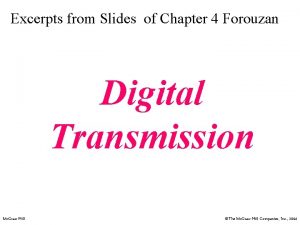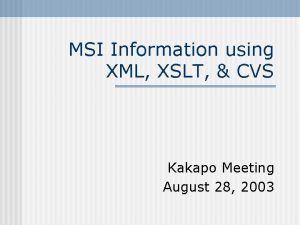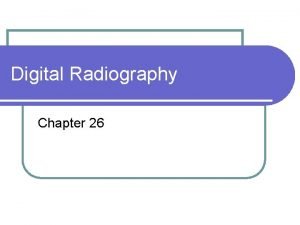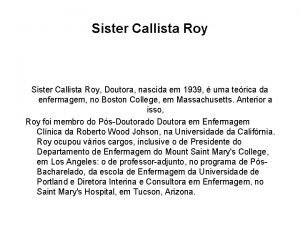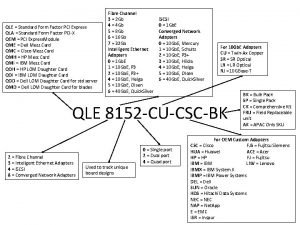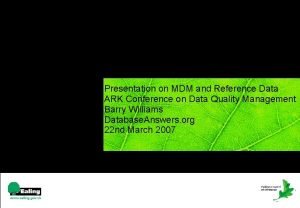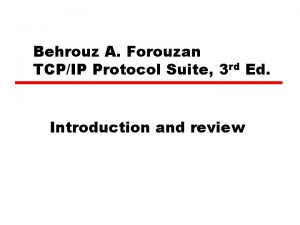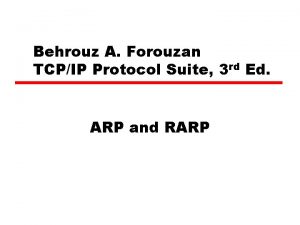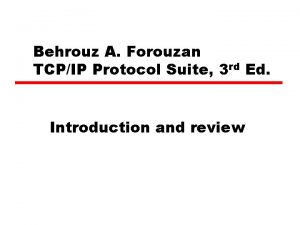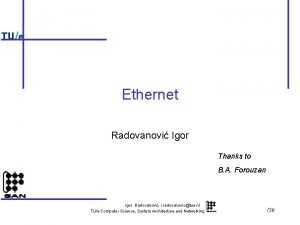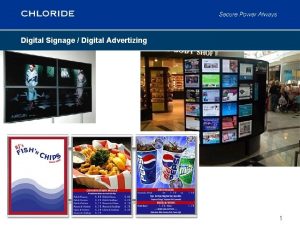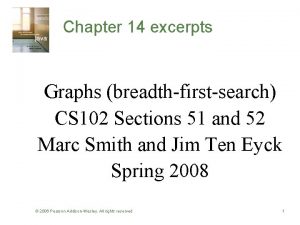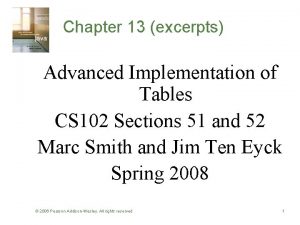Excerpts from Slides of Chapter 4 Forouzan Digital






































- Slides: 38

Excerpts from Slides of Chapter 4 Forouzan Digital Transmission Mc. Graw-Hill ©The Mc. Graw-Hill Companies, Inc. , 2004

4. 1 Line Coding Some Characteristics Line Coding Schemes Some Other Schemes Mc. Graw-Hill ©The Mc. Graw-Hill Companies, Inc. , 2004

Figure 4. 1 Mc. Graw-Hill Line coding ©The Mc. Graw-Hill Companies, Inc. , 2004

Figure 4. 3 Mc. Graw-Hill DC component ©The Mc. Graw-Hill Companies, Inc. , 2004

Figure 4. 4 Mc. Graw-Hill Lack of synchronization ©The Mc. Graw-Hill Companies, Inc. , 2004

Example 3 In a digital transmission, the receiver clock is 0. 1 percent faster than the sender clock. How many extra bits per second does the receiver receive if the data rate is 1 Kbps? How many if the data rate is 1 Mbps? Solution At 1 Kbps: 1000 bits sent 1001 bits received 1 extra bps At 1 Mbps: 1, 000 bits sent 1, 000 bits received 1000 extra bps Mc. Graw-Hill ©The Mc. Graw-Hill Companies, Inc. , 2004

Figure 4. 5 Mc. Graw-Hill Line coding schemes ©The Mc. Graw-Hill Companies, Inc. , 2004

Note: Unipolar encoding uses only one voltage level. Mc. Graw-Hill ©The Mc. Graw-Hill Companies, Inc. , 2004

Figure 4. 6 Mc. Graw-Hill Unipolar encoding ©The Mc. Graw-Hill Companies, Inc. , 2004

Note: Polar encoding uses two voltage levels (positive and negative). Mc. Graw-Hill ©The Mc. Graw-Hill Companies, Inc. , 2004

Figure 4. 7 Mc. Graw-Hill Types of polar encoding ©The Mc. Graw-Hill Companies, Inc. , 2004

Note: In NRZ-L the level of the signal is dependent upon the state of the bit. Mc. Graw-Hill ©The Mc. Graw-Hill Companies, Inc. , 2004

Note: In NRZ-I the signal is inverted if a 1 is encountered. Mc. Graw-Hill ©The Mc. Graw-Hill Companies, Inc. , 2004

Figure 4. 8 Mc. Graw-Hill NRZ-L and NRZ-I encoding ©The Mc. Graw-Hill Companies, Inc. , 2004

Note: A good encoded digital signal must contain a provision for synchronization. Mc. Graw-Hill ©The Mc. Graw-Hill Companies, Inc. , 2004

Figure 4. 10 Mc. Graw-Hill Manchester encoding ©The Mc. Graw-Hill Companies, Inc. , 2004

Note: In Manchester encoding, the transition at the middle of the bit is used for both synchronization and bit representation. Mc. Graw-Hill ©The Mc. Graw-Hill Companies, Inc. , 2004

Figure 4. 11 Mc. Graw-Hill Differential Manchester encoding ©The Mc. Graw-Hill Companies, Inc. , 2004

Note: In differential Manchester encoding, the transition at the middle of the bit is used only for synchronization. The bit representation is defined by the inversion or noninversion at the beginning of the bit. Mc. Graw-Hill ©The Mc. Graw-Hill Companies, Inc. , 2004

4. 3 Sampling Pulse Amplitude Modulation Pulse Code Modulation Sampling Rate: Nyquist Theorem How Many Bits per Sample? Bit Rate Mc. Graw-Hill ©The Mc. Graw-Hill Companies, Inc. , 2004

Figure 4. 18 Mc. Graw-Hill PAM ©The Mc. Graw-Hill Companies, Inc. , 2004

Note: Pulse amplitude modulation has some applications, but it is not used by itself in data communication. However, it is the first step in another very popular conversion method called pulse code modulation. Mc. Graw-Hill ©The Mc. Graw-Hill Companies, Inc. , 2004

Figure 4. 19 Mc. Graw-Hill Quantized PAM signal ©The Mc. Graw-Hill Companies, Inc. , 2004

Figure 4. 20 Mc. Graw-Hill Quantizing by using sign and magnitude ©The Mc. Graw-Hill Companies, Inc. , 2004

Figure 4. 21 Mc. Graw-Hill PCM ©The Mc. Graw-Hill Companies, Inc. , 2004

Figure 4. 22 Mc. Graw-Hill From analog signal to PCM digital code ©The Mc. Graw-Hill Companies, Inc. , 2004

Note: According to the Nyquist theorem, the sampling rate must be at least 2 times the highest frequency. Mc. Graw-Hill ©The Mc. Graw-Hill Companies, Inc. , 2004

Figure 4. 23 Mc. Graw-Hill Nyquist theorem ©The Mc. Graw-Hill Companies, Inc. , 2004

Example 4 What sampling rate is needed for a signal with a bandwidth of 10, 000 Hz (1000 to 11, 000 Hz)? Solution The sampling rate must be twice the highest frequency in the signal: Sampling rate = 2 x (11, 000) = 22, 000 samples/s Mc. Graw-Hill ©The Mc. Graw-Hill Companies, Inc. , 2004

Example 5 A signal is sampled. Each sample requires at least 12 levels of precision (+0 to +5 and -0 to -5). How many bits should be sent for each sample? Solution We need 4 bits; 1 bit for the sign and 3 bits for the value. A 3 -bit value can represent 23 = 8 levels (000 to 111), which is more than what we need. A 2 -bit value is not enough since 22 = 4. A 4 -bit value is too much because 24 = 16. Mc. Graw-Hill ©The Mc. Graw-Hill Companies, Inc. , 2004

Example 6 We want to digitize the human voice. What is the bit rate, assuming 8 bits per sample? Solution The human voice normally contains frequencies from 0 to 4000 Hz. Sampling rate = 4000 x 2 = 8000 samples/s Bit rate = sampling rate x number of bits per sample = 8000 x 8 = 64, 000 bps = 64 Kbps Mc. Graw-Hill ©The Mc. Graw-Hill Companies, Inc. , 2004

Figure 4. 25 Mc. Graw-Hill Parallel transmission ©The Mc. Graw-Hill Companies, Inc. , 2004

Figure 4. 26 Mc. Graw-Hill Serial transmission ©The Mc. Graw-Hill Companies, Inc. , 2004

Note: In asynchronous transmission, we send 1 start bit (0) at the beginning and 1 or more stop bits (1 s) at the end of each byte. There may be a gap between each byte. Mc. Graw-Hill ©The Mc. Graw-Hill Companies, Inc. , 2004

Note: Asynchronous here means “asynchronous at the byte level, ” but the bits are still synchronized; their durations are the same. Mc. Graw-Hill ©The Mc. Graw-Hill Companies, Inc. , 2004

Figure 4. 27 Mc. Graw-Hill Asynchronous transmission ©The Mc. Graw-Hill Companies, Inc. , 2004

Note: In synchronous transmission, we send bits one after another without start/stop bits or gaps. It is the responsibility of the receiver to group the bits. Mc. Graw-Hill ©The Mc. Graw-Hill Companies, Inc. , 2004

Figure 4. 28 Mc. Graw-Hill Synchronous transmission ©The Mc. Graw-Hill Companies, Inc. , 2004
 Forouzan slides
Forouzan slides Forouzan
Forouzan Code of chivalry
Code of chivalry Excerpts from macbeth
Excerpts from macbeth French revolutio
French revolutio A small child slides down the four frictionless slides
A small child slides down the four frictionless slides A child is on a playground swing motionless
A child is on a playground swing motionless Pismere
Pismere Jelaskan warga digital
Jelaskan warga digital Digital market and digital goods
Digital market and digital goods Digital data digital signals
Digital data digital signals Data encoding and modulation
Data encoding and modulation E-commerce: digital markets, digital goods
E-commerce: digital markets, digital goods Data encoding techniques in computer networks
Data encoding techniques in computer networks Rdi board
Rdi board Unique features of digital markets
Unique features of digital markets Digital marketing chapter 1
Digital marketing chapter 1 Digital fundamentals chapter 4
Digital fundamentals chapter 4 Digital electronics chapter 1
Digital electronics chapter 1 Chapter 1 careers in the digital age
Chapter 1 careers in the digital age Chapter 39 digital imaging film and radiographs
Chapter 39 digital imaging film and radiographs Chapter 39 digital imaging film and radiographs
Chapter 39 digital imaging film and radiographs Caráter significado
Caráter significado Architecture runway slides
Architecture runway slides Verbos direcionais em libras
Verbos direcionais em libras Slidesmania
Slidesmania Splat steve wyborney google slides
Splat steve wyborney google slides Fidel castro
Fidel castro Uipath enterprise rpa platform
Uipath enterprise rpa platform Statquest josh starmer
Statquest josh starmer Data mining slides
Data mining slides Quem foi callista roy
Quem foi callista roy Ria slides
Ria slides Ria slides
Ria slides Qla slides
Qla slides Tonoscopia formula
Tonoscopia formula Bru company
Bru company Master data management slides
Master data management slides Starfish development slides labeled
Starfish development slides labeled
